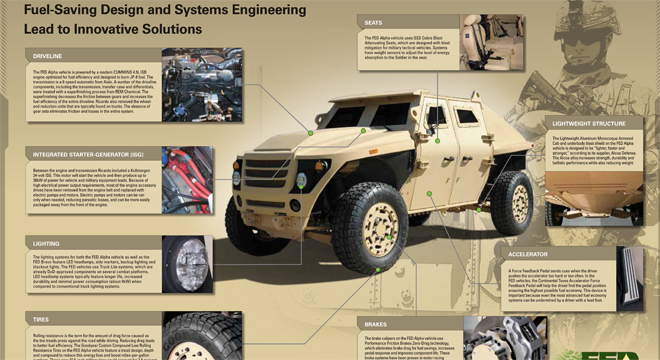A green revival could be in store for GM’s Hummer, that late 20th century icon of gas-guzzling excess famously associated in the public mind with Arnold Schwarzenegger.
The notoriously oversized passenger car was based on the military’s Humvee, and now the U.S. Amy is unveiling two next-generation Humvee prototypes that use 70 percent less fuel than a comparable model, the M1114 Humvee.
One of the new prototypes is a diesel-fueled model called the Fuel Efficient Ground Vehicle Demonstrator, or FED Alpha for short. It has been undergoing testing at the Aberdeen Test Center in Maryland.
The other prototype, FED Bravo, has a hybrid-electric drive. It will be ready for testing later this year.
Since a conventional fully armored Humvee only gets about 4 mpg, a 70 percent savings only translates into a fuel efficiency of about seven to twelve miles per gallon for the FED vehicles, depending on whether the mission is in urban areas or open highways. That might not seem too impressive, but even a modest increase in fuel efficiency would translate into significant savings on the Army’s annual fuel costs, while reducing the risk to soldiers escorting fuel convoys to remote bases.
Part of the fuel savings for the FED Alpha – about 7.8 percent – comes simply from switching to low-rolling tires that reduce the drag that occurs as the treads press against the road.
Driver cooperation is another important fuel efficiency factor. As the Army notes in background materials for the FED program, “even the most advanced fuel economy systems can be undermined by a driver with a lead foot.” To get around that, the Alpha’s gas pedal is designed to vibrate and resist when a driver tries to go faster than the most fuel-efficient maximum speed, though there is an override for emergencies.
The FED Alpha also minimizes excess weight by using aluminum and aluminum alloys in structural elements including the armored cab and the blast shield under the vehicle.
As for other significant fuel saving features, unfortunately they are well beyond the reach of the consumer market at the present time. They derive from numerous customizations including specially treated low-friction parts, courtesy of the British engineering firm Ricardo.
A custom engine, custom transmission and lightweight, high-performance brakes similar to those used in racing cars are other fuel-saving components that most car buyers probably wouldn’t want to shell out for.
However, according to Steve Kramer of the Army Tank and Automotive Research, Development and Engineering Command (TARDEC,) FED Alpha and Bravo were designed as a demonstration models, with the expectation that at least some fuel-saving elements will become cost effective to mass produce, and cross into the consumer market.
In other words, if someone ever decides to revive GM’s notorious Hummer, it could end up doing do a lot better than its 2010 highway rating of only 12 mpg on an ethanol blend.
In addition to showcasing innovative technology, the FED program showcases a new track for vehicle development that could also make its influence the way car manufacturers design fuel-saving features for civilian consumers.
FED Bravo was developed through an unusual collaborative process that deployed experts in government, the private sector and academia – including students – to analyze cutting edge fuel saving technologies across the automotive industry, setting up a contrast with FED Alpha, which was developed using a conventional path that involved embedding TARDEC engineers with a contractor.
The FED Bravo collaborative effort will be familiar to car fans through Discovery Channel’s team-based game show “Monster Garage.” TARDEC even highlights Monster Garage in its official FED backgrounder.
Regular readers of TPM’s Idea Lab will also recognize that group collaboration and the inclusion of students, hobbyists or citizen-scientists in federal research projects is becoming a familiar part of the toolkit at other agencies such as DARPA and NASA.






